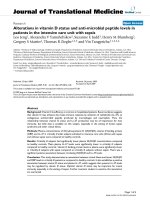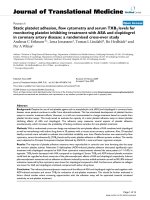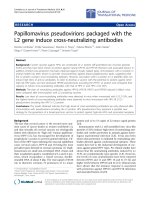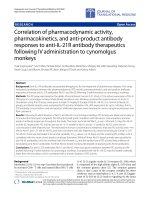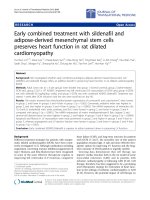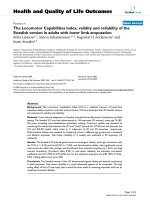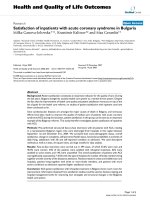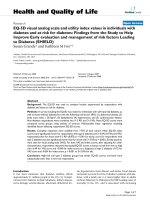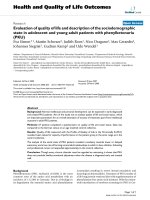Báo cáo hóa học: " Nanostructured Silver Substrates With Stable and Universal SERS Properties: Application to Organic " pot
Bạn đang xem bản rút gọn của tài liệu. Xem và tải ngay bản đầy đủ của tài liệu tại đây (456.17 KB, 7 trang )
NANO EXPRESS
Nanostructured Silver Substrates With Stable and Universal
SERS Properties: Application to Organic Molecules
and Semiconductor Nanoparticles
M. V. Chursanova
•
V. M. Dzhagan
•
V. O. Yukhymchuk
•
O. S. Lytvyn
•
M. Ya. Valakh
•
I. A. Khodasevich
•
D. Lehmann
•
D. R. T. Zahn
•
C. Waurisch
•
S. G. Hickey
Received: 11 September 2009 / Accepted: 16 November 2009 / Published online: 27 November 2009
Ó The Author(s) 2009. This article is published with open access at Springerlink.com
Abstract Nanostructured silver films have been prepared
by thermal deposition on silicon, and their properties as
SERS substrates investigated. The optimal conditions of
the post-growth annealing of the substrates were estab-
lished. Atomic force microscopy study revealed that the
silver films with relatively dense and homogeneous arrays
of 60–80-nm high pyramidal nanoislands are the most
efficient for SERS of both organic dye and inorganic
nanoparticles analytes. The noticeable enhancement of the
Raman signal from colloidal nanoparticles with the help of
silver island films is reported for the first time.
Keywords SERS Á Ag/Si nanoisland films Á
Post-growth annealing Á Rhodamine 6G Á CdSe Á
Nanoparticles
Introduction
The field of physical and chemical phenomena related to the
interaction of molecules and other nanoobjects with plas-
mons localized in or propagating over specially designed
noble metal nanostructures has received increasing interest
in recent years [1–8]. The great progress achieved in both
the technology of metal nanostructures with necessary
parameters and in theoretical modelling of many particular
problems has led to a broad involvement of plasmon-med-
iated phenomena in the fields of optoelectronics, medical
diagnostics and treatment, sensor technologies, etc. [5, 7].
Among these phenomena surface-enhanced Raman scat-
tering (SERS) and photoluminescence are believed to have
great perspectives in single-molecule chemical and bio-
sensing and in vivo medical diagnostics [5, 6].
Surface enhanced Raman scattering (SERS) has proven
to be one of the most powerful analytical tools. This phe-
nomenon represents strong increase of the Raman signal
from analyte molecules deposited on nanostructured
metallic surface.
There are two main mechanisms of SERS, long-range
electromagnetic effect and short-range chemical effect. The
part of electromagnetic mechanism in the resulting intensity
is dominating (about 10
4
–10
7
), while chemical mechanism
contributes only about 10–10
2
[1]. Chemical mechanism
acts only for the first layer of analyte in direct contact with
metallic surface, when charge transfer between surface and
adsorbate molecule can occur. Electromagnetic mechanism
is caused by electric field enhancement by excitation of
surface plasmon resonance in proximity with nanoscale
roughness [2].
One of the main prerequisites for a wide range of appli-
cations of surface enhanced spectroscopy is the availability
of non-expensive nanostructured metal substrates with a
M. V. Chursanova (&)
National Technical University of Ukraine ‘‘KPI’’, 37 Prospect
Peremohy, 03056 Kyiv, Ukraine
e-mail: afi
V. M. Dzhagan Á V. O. Yukhymchuk Á O. S. Lytvyn Á
M. Ya. Valakh
V. Lashkaryov Institute of Semiconductor Physics, National
Academy of Sciences of Ukraine, 03028 Kyiv, Ukraine
I. A. Khodasevich
B.I. Stepanov Institute of Physics of National Academy of
Sciences of Belarus, 220072 Minsk, Belarus
D. Lehmann Á D. R. T. Zahn
Semiconductor Physics, Chemnitz University of Technology,
09107 Chemnitz, Germany
C. Waurisch Á S. G. Hickey
Physical Chemistry/Electrochemistry, IFW Dresden, 01171
Dresden, Germany
123
Nanoscale Res Lett (2010) 5:403–409
DOI 10.1007/s11671-009-9496-2
morphology optimized for a maximum enhancement. The
main approaches towards the preparation of such substrates
are colloidal synthesis, use of templates, etching, and self-
assembled formation of rough (island-like) metal surfaces
[8]. Colloidal metal nanoparticles (NPs) are relatively
inexpensive, and a narrow size dispersion of NPs can be
obtained, which allows spectrally narrow plasmon peaks to
be obtained [8]. While even better homogeneity of the
nanostructures and related plasmon characteristics can be
achieved by etching and using templates, these kinds of
methods are more expensive. Self-assembled growth of
island metal films on dielectric or semiconductor substrates
can be a good candidate for obtaining SERS substrates with
an acceptable ratio of price/quality, provided that the nec-
essary homogeneity of the island size is achieved [5, 9–11].
Furthermore, investigations of the SERS effect on various
kinds of metal nanostructures and analyte will contribute to
the understanding of the role of electromagnetic and
chemical contributions to this effect—an issue intensively
discussed due to both application importance and funda-
mental interest [12, 13].
Here, we report a study of the relation between the
preparation conditions of island-like silver substrates, their
morphology, and SERS properties. Rhodamine 6G (Rh6G)
was chosen as an analyte due to its broad application as
fluorescent labelling and sensing reagent [14, 15], as well
as due to its common use as an analyte in testing SERS
substrates [16]. In addition, the SERS spectra of the
nanoparticles of an inorganic semiconductor, CdSe, are
also obtained and analysed. In contrast to the huge work
done on SERS experiments with molecules as analyte
[1–3], only a few attempts succeeded in observing surface
enhancement of Raman signal from semiconductor nano-
particles as analyte [17–23]. At the same time, the effect of
interaction with the plasmon onto the optical and electrical
properties of semiconductor NPs is presently an intense
field of research [24]. The reported successful SERS
experiments on semiconductor NPs were realized using
colloidal Ag NPs [17, 21, 22], Ag–CdS composites formed
by the Langmuir–Blodgett technique [23], or by thermal
deposition of silver onto the epitaxialy grown nanostruc-
tures [19, 20]. In the present work, SERS of colloidal
semiconductor NPs deposited on silver island film is
reported for the first time.
Experimental
The initial Ag/Si nanoisland film was prepared by thermal
evaporation of silver onto a cleaned silicon substrate at
room temperature. The nominal thickness of the silver
deposited was adjusted to (10 ± 2) nm, as estimated from
the known time and rate of deposition. A series of the
samples was produced by annealing of the initial Ag/Si
films under ambient or nitrogen atmosphere. The actual
dimensions of both the initial surface roughness and of the
islands obtained after thermal treatment were derived from
atomic force microscopy (AFM) images of the surface.
AFM images were taken using a NanoScope IIIa set-up
(Digital Instruments) operating in the tapping mode. The
SERS experiments were performed using Rhodamine 6G,
Cu porphyrin CuTMPy, or colloidal CdSe nanoparticles as
analytes. Raman spectra of the samples were excited with
the 514.5-nm line of an Ar
?
ion laser with a power on
sample of 5 mW and registered with using a Renishaw
Ramascope 2000.
The synthesis of CdSe and CdSe/ZnS NPs was under-
taken following a modified procedure of Peng et al. [25].
Cadmium oxide (CdO, 99.5%), 1-octadecene (ODE), oleic
acid (OA), trioctylphosphine oxide (TOPO, 99%), Zinc
acetate (ZnAc
2
, 99.99%), Sulphur powder (S, 99.98%) and
all organic solvents were purchased from Aldrich. Hexa-
decylamine (HDA, [99%), octadecylamine (ODA, [90%)
and n-trioctylphosphine (TOP) were obtained from Fluka
and Selenium powder (Se, 99.99%) was purchased from
ChemPur. All chemicals were used without further treat-
ment, except TOP which was purified by distillation. In a
typical synthesis of CdSe nanocrystals, a mixture of
0.4 mmol of CdO, 2 mmol of OA in 9.5 g of ODE was
heated to 100°C under vacuum for 30 min to remove any
residual oxygen and moisture. Under inert (Ar) atmo-
sphere, this mixture was further heated to 300°C until a
clear, colourless solution was obtained. After cooling this
solution to 100°C, 5 mmol of TOP and 8 mmol of HDA
were added and the resulting mixture was kept at 100°C
under vacuum for 30 min. After heating to 270°C under
inert atmosphere, a mixture of 0.4 mmol of Se in 4.5 mmol
TOP and 1.5 g ODE was swiftly injected and the solution
temperature held at 245°C until the desired particle size
was obtained. The resulting particles were then purified by
precipitation with an iso-propanol/methanol mix and
redissolved in hexane or toluene.
The shell growth was carried out using the SILAR
technique [25]. An aliquot containing 10
-4
mmol of CdSe
nanocrystals in hexane was combined with 1.5 g of ODA
and 5.0 g of ODE and heated to 100°C under vacuum for
30 min to remove any residual oxygen and moisture.
Subsequently the system was switched to inert atmosphere
and heated to 240°C for the shell growth. The shell growth
was achieved by a series of alternating injections of a
solution of ZnAc
2
/OA/ODE (0.04 M, OA:ODE = 1:3) and
S/ODE (0.04 M). The purification steps for the core/shell
nanoparticles were as previously described for the uncoa-
ted CdSe nanocrystals.
404 Nanoscale Res Lett (2010) 5:403–409
123
Results and Discussion
The growth of silver on silicon is known to follow the
Stranski–Krastanov mechanism, i.e. formation of a con-
tinuous Ag wetting layer with three-dimensional pyramid-
like islands on it. However, with annealing at high tem-
peratures T
ann
in the range of 300–600°C, the interaction
energy between silver atoms becomes stronger than the
interaction energy between silver and silicon substrate and
ripening of 3D silver islands is enhanced.
The AFM image of the surface of the initial Ag/Si
sample studied in the present work is shown in Fig. 1a. As
one can see, the surface roughness is quite inhomogeneous,
with an average height of the islands of about 1 nm. After
15 min of thermal annealing of the film at 550°C under air
atmosphere, a quite dense array of islands is formed, with
the island height increased up to (70 ± 10) nm (Fig. 1b).
As the annealing time, t
ann
, goes up to 30 min, the reverse
process of islands collapsing takes place and their number
per surface area unit and average height increases at the
expense of the mean island size decrease. Already for
t
ann
= 30 min, the surface morphology becomes again
close to the initial (not annealed) film (Fig. 1c).
The measurements of the Raman spectra of 10
-5
M
Rhodamine 6G, deposited onto the surface of the Ag island
films, revealed that the enhancement factor is strongly
dependent on the morphology of the film and determined by
annealing time. In particular, for the T
ann
= 550°C, the
optimum parameters of the island film are achieved at the
t
ann
= 15–20 min (Fig. 2). Therefore, it can be concluded
from comparison of the morphology and SERS spectra that
for the maximum enhancement rather dense arrays of
islands with size of ten to several tens of nm are preferable
(Fig. 1). At that, the intensity of Raman features for samples
with rather different island morphology, corresponding to
15 and 30 min of annealing, is rather comparable, while the
substrates with more similar morphologies, corresponding
to the initial film and that annealed for 30 min, reveal drastic
difference of the enhancement properties (Fig. 2). To
explain this fact, we assume that along with the apparent
morphology (seen in AFM-images) other factors can play a
significant role in determining the enhancement factor. One
of such factors can be different thickness of the silver oxide
layer on the surface of the films. In particular, the surface of
the initial films is supposed to have a negligible (thinnest)
oxide layer. Its surface is more likely covered with silver
sulphide due to the reaction between silver and H
2
S from air
during the storage of the films under air. The sulphide film
can probably be removed during the high-temperature
annealing. Instead, silver oxide forms, which positively
influences the enhancement property of the island film, with
the oxide thickness increasing with t
ann
. We return to this
discussion at the end of the manuscript.
Based on a relatively strong intensity of the peaks at 613
and 775 cm
-1
, which are markers for charge transfer
(chemical) component of the SERS on Rh6G (Fig. 2, inset)
[26], we can conclude that the chemical mechanism also
contributes to the enhancement in our case.
The annealing temperature is another crucial factor
governing the Ag/Si films surface morphology. The increase
of T
ann
increases the average height of nanoislands (Fig. 3)
and this improves enhancing characteristics of such sub-
strates, up to T
ann
of about 550°C. The highest SERS effi-
ciency is produced by substrates annealed at temperatures
500–550°C. The reason is probably that closely positioned
nanoislands of appropriate size (height of 70 ± 10 nm) and
relatively large surface density are formed, as can be seen
from the corresponding AFM image (Fig. 3c). At increase
of the annealing temperature above 600°C, ‘‘melting’’ and
‘‘merging’’ of islands occur (Fig. 3d) and their SERS
activity deteriorates. The Raman signal surface enhance-
ment level of the sample annealed at 610°C is about 15 times
weaker than that of the sample annealed at 550°C. At the
same time, the enhancement factor achieved with the Ag/Si
film annealed at 550°C is two orders of magnitude larger
than for 350°C (Fig. 4). The absolute enhancement for the
substrate annealed at 550°C is at least three orders of
magnitude, but the exact value was not possible to be
derived from the present experiments. The reason is that no
Raman signal could be registered from the given concen-
tration of analyte deposited on the initial (not annealed) Ag
film.
Special attention in the present work was paid to the
stability of the prepared SERS substrates to environment
during long storage or multiple use. It was found that the
enhancement factor of the Ag/Si substrates does not change
significantly after storage for months under ambient
atmosphere. For example, the spectra shown in Figs. 2 and
4 were taken from freshly deposited analyte on Ag/Si
nanoisland films after a 5-month storage. This clearly
indicates the stability of the surface morphology of such
nanostructured films. Probably, one of the factors which
provide such stability is the (thin) layer of silver oxide
formed during annealing in air. The presence of such oxide
layer was revealed in the Raman spectra and will be dis-
cussed in the following paragraphs. Moreover, the role of
the oxide in the SERS activity of such substrates is further
confirmed by the fact that the substrates annealed in inert
(nitrogen) atmosphere did not possess noticeable SERS
activity.
We also investigated the stability of the substrates pre-
pared with respect to multiple use for one and the same
analyte, as well as for different analyte. Immediately after
deposition of an analyte and its spectra registration, the
nanoisland films were kept and rinsed in ethanol for 1 h
and then another analyte was deposited on them again and
Nanoscale Res Lett (2010) 5:403–409 405
123
the next measurements were carried out. The subsequent
measurements gave Raman signals of the same order of
magnitude.
The Raman spectra of CuTMPy of different concentra-
tion were also studied. The maximum enhancement was
achieved for Ag/Si nanoisland films obtained at T
ann
=
500–550°C (Fig. 5), similarly to the Rh6G analyte. One of
the main Raman bands of CuTMPy was registered at
concentrations down to 10
-6
M.
At low signal intensities from the analyte molecule, like
in Fig. 5, we could observe two additional features centred
near 1,350 and 1,600 cm
-1
, correspondingly. These fea-
tures can be attributed to scattering by vibrational modes of
silver oxide, Ag
2
O[27], formed on the surface of the island
film during high-temperature annealing. Interestingly, these
two Raman peaks change in intensity almost synchronously
with the analyte peak (Fig. 5). We believe that the Ag
2
O
vibrations also undergo surface enhancement and the var-
iation of their intensity with temperature of the Ag layer
annealing is not a result of different Ag
2
O volume. If the
latter were the case, we would expect an increase of the
Ag
2
O-related Raman signal for the substrate obtained at
600°C (Fig. 5). Instead we observe negligible peak inten-
sity for this T
ann
, which correlates with the low intensity of
the analyte peak and indicates an enhancement for both
features via the SERS effect.
Growing fundamental and applied interest in manipu-
lating the optical and electronic properties of semicon-
ductor NPs by plasmon fields generated in adjacent
nanostructured metal has been observed in recent years
[3–7]. In view of this interest, we investigated the SERS
effect on colloidal CdSe NPs. Two kinds of NPs were
investigated. The NPs of the first kind were homogenous
(bare) CdSe NPs capped by organic ligands to preclude
their aggregation. The CdSe NPs of the second kind were
core-shell systems consisting of a CdSe core capped with a
thin ZnS shell. The diameter of the core was about 3 nm,
the shell thickness was approximately 0.5–1 nm. The
diameter of the CdSe core was determined from the spec-
tral position of the first absorption maximum, based on the
relations derived in [16].
Unlike the spectrum of the control sample with the same
concentration of NPs deposited on glass, bare silicon or the
unannealed (initial) Ag film, the surface enhancement
effect induced by the Ag nanoisland film allowed for both
CdSe and CdSe/ZnS NPs the Raman bands attributed to the
longitudinal optical (LO) phonon of CdSe core at
203 cm
-1
and its overtone (2LO) near 400 cm
-1
to be
recorded (Fig. 6). The largest Raman signal enhancement
was observed for Ag/Si substrates annealed at temperatures
Fig. 1 AFM images and corresponding surface profiles of Ag/Si nanoisland films: unannealed film a and films annealed in air at 550°C for b 15
and c 30 min
Fig. 2 Raman spectra of 10
-5
M Rh6G on Ag/Si nanoisland films
annealed at 550°C and different annealing times. Inset shows the
lower frequency peaks at 613 and 775 cm
-1
406 Nanoscale Res Lett (2010) 5:403–409
123
Fig. 3 AFM images and
corresponding surface profiles
of Ag/Si nanoisland films
annealed in air during 15 min at
a 350°C, b 420°C, c 550°C and
d 650°C
Fig. 4 Raman spectra of 10
-5
M Rh6G measured on Ag/Si nanois-
land films, obtained by annealing at different temperatures for 15 min
Fig. 5 Raman spectra of 10
-6
M CuTMPy measured on Ag/Si
nanoisland films, annealing time 15 min
Nanoscale Res Lett (2010) 5:403–409 407
123
400–500°C, which differ from the temperatures optimal
for the case discussed earlier of molecular analyte, R6G
(500–550°C).
As SERS is known to be a short-range effect due to the
drastic drop of the plasmon field magnitude at distances of
several nanometer from the metal surface [3], one might
expect the predominant enhancement of the Raman peaks
corresponding to the atomic vibration on the surface or in
the near-surface region of the NP. This assumption is in
agreement with the results of Ref. [21] where an SERS
signal was obtained from the thin CdS shell of the surface
of CdTe/CdS NPs, while no signal from the CdTe core was
registered. In the present study, we did not observe the
Raman peak related to the ZnS shell, expected around
350 cm
-1
, neither in the ordinary nor in the SERS spec-
trum (Fig. 7). The fact that the Zn–S vibrational mode is
commonly not possible to register in an ordinary Raman
scattering measurement on CdSe/ZnS NPs [28, 29] can be
easily explained by the off-resonance conditions of the
visible laser excitations with the electronic transitions in
the ZnS shell. Instead we observe in both spectra the fea-
ture *270–280 cm
-1
, previously assigned to the Cd–S
vibrations at the intermixed core-shell interface [28, 29].
The intensity of this Cd–S mode is very close in both
(normalized) spectra (Fig. 7). This fact indicates that the
enhancement of this mode is the same as for the core-
related LO phonon. The absence of the shell-related peak,
as well as the fact that the optimum annealing temperature
(and therefore the Ag film morphology and its plasmon
parameters) differs for SERS of Rh6G and semiconductor
NPs indicate that the resonant excitation of the plasmon
alone is not enough to cause the SERS effect of the
semiconductor NPs. The excitation wavelength should also
be resonant with certain electronic transition of the NP
(either core or shell), for the corresponding vibrations to be
observed in the resonant Raman spectra. This case of
double resonance takes place for the exciton (e-h) transi-
tions of the CdSe core, as the excitation energy used
(2.4 eV) is well above the absorption onset of the NPs
(1.9 eV). On the contrary, no resonance is realized at these
conditions for the electronic transition of the thin ZnS
shell, because the bandgap is as large as 3.6 eV for bulk
ZnS crystal [30] and is equal to and can reach more than
4.3 eV in the very thin (sub-nm) layer due to quantum
confinement effect [31].
One of the inherent (i.e. not from the shell) surface-
related vibrational modes reported for semiconductor NPs,
which might be expected to be enhanced in SERS spec-
trum, is the so-called surface optical (SO) phonon [32–34].
The frequency of the SO mode is usually 15–25 cm
-1
below that of the corresponding longitudinal optical (LO)
phonon related to the internal (bulk-like) undistorted part
of the NPs. The SO mode is usually observed as a more or
less distinct shoulder on the lower frequency side of the LO
peak (Fig. 7)[32–34]. By comparing the lineshape of the
SERS and the ordinary spectra in the region of SO and LO
modes (Fig. 7), we can conclude that the enhancement is of
the same magnitude for LO and SO modes. Our results
qualitatively agree with those obtained in Refs. [17, 18,
23]. The latter results may indicate that the enhancement of
Raman scattering by (bulk-like) LO phonons occurs via
enhanced absorption of the exciting light in NPs, mediated
by the plasmon excitation. Therefore, the SERS effect in
this case occurs not locally but for the NPs as a whole. This
Fig. 6 Raman spectra of CdSe/ZnS NPs on unannealed Ag/Si
substrates and nanoisland films formed by annealing for 15 min at
430 and 520°C
Fig. 7 Normalized Raman spectra of the same NPs sample with
plasmon enhancement (grey) and without it (black). The SERS
spectrum is same as in Fig. 6 for T
ann
= 430°C. The ordinary
spectrum was obtained by deposition of NPs from a highly
concentrated solution onto the bare Si surface
408 Nanoscale Res Lett (2010) 5:403–409
123
fact can be an indication of the spatial extension of the
plasmon enhancement being noticeable even at the distance
of several nm from the metal surface, in accordance with
Otto etal. [35, 36]. The concentration of the exciting light
energy near the apex of silver nanoislands of special
morphology leads to the generation of a larger number of
excitons (electron-hole pairs) inside the adjacent semi-
conductor NPs. The latter means a larger number of the
phonon scattering events. The probability of the scattering
on the strength of the electron- (exciton-) phonon coupling
(EPC) may thus be the same as in the ordinary (resonant)
RS. The value of the EPC strength can be estimated from
the intensity ratio of the LO peak and its overtone (near
415 cm
-1
)[29], and this value is very close in both the
SERS and RRS spectra (Fig. 7).
Conclusions
We have studied the dependence of the SERS efficiency of
nanostructured silver films, prepared by thermal deposition
on silicon, on the parameters of their post-growth annealing.
It was found that the annealing under ambient but not inert
atmosphere gives the remarkable enhancement factor. The
optimal conditions of a post-growth annealing of the sub-
strates have been established to be T
ann
= 400–550°C and
duration of 15–20 min. Atomic force microscopy study
revealed the relatively dense and homogenous array of
60–80-nm high pyramidal nanoislands, formed at such
annealing conditions, to be most efficient for SERS of both
organic dye and inorganic nanoparticles analyte. The
noticeable enhancement of the Raman signal from colloidal
semiconductor nanoparticles with help of silver island films
is reported for the first time (in opposite to using of colloidal
Ag in [21] or Langmuir–Blodgett technique in [20]).
Acknowledgments Authors are grateful to D. Cojoc from CNR-
INFM, Laboratorio Nazionale TASC, Area Science Park—Basovizza,
Trieste, Italy for the help with carring out Raman spectra measure-
ments and useful advice. V. Dzhagan is grateful to the Alexander von
Humboldt Foundation for financial support of his work.
Open Access This article is distributed under the terms of the
Creative Commons Attribution Noncommercial License which per-
mits any noncommercial use, distribution, and reproduction in any
medium, provided the original author(s) and source are credited.
References
1. R.A. Tripp, R.A. Dluhy, Y. Zhao, Nanotoday 3(3–4), 31 (2008)
2. Z. Lu, Y. Gu, J. Yang, Z. Li, W. Ruan, W. Xu, C. Zhao, B. Zhao,
Vib. Spectrosc. 47, 99 (2008)
3. K. Kneipp, M. Moskovits, H. Kneipp (eds.), Surface-Enhanced
Raman Scattering: Physics and Applications (Springer, Belin,
2006)
4. J.R. Lakowicz, K. Ray, M. Chowdhury, H. Szmacinski, Y. Fu,
J. Zhang, K. Nowaczyk, Analyst 133, 1308 (2008)
5. M. Culha, D. Stokes, L.R. Allain, T. Vo-Dinh, Anal. Chem. 75,
22–6196 (2003)
6. X M. Qian, S.M. Nie, Chem. Soc. Rev. 37, 912 (2008)
7. W.E. Smith, Chem. Soc. Rev. 37, 955 (2008)
8. A.M. Schwartzberg, J.Z. Zhang, J. Phys. Chem. C 112(28), 10323
(2008)
9. Y. Ito, K. Matsuda, and Y. Kanemitsu Phys. Rev.B 75, 033309
(2007)
10. G. Lu, H. Shen, B. Cheng, Z. Chen, C.A. Marquette, L.J. Blum,
O. Tillement, S. Roux, G. Ledoux, M. Ou, P. Perriat, Appl. Phys.
Lett. 89, 223128 (2006)
11. P.W. Li, J. Zhang, L. Zhang, Y.J. Mo, Vib. Spectrosc. 49,2
(2009)
12. M. Sun, S. Wan, Y. Liu, Y. Jia, Hongxing Xu, J. Raman Spec-
trosc. 39, 402 (2008)
13. M. Moskovits, Rev. Mod. Phys. 57, 783 (1985)
14. Y. Shiraishi, S. Sumiya, Y. Kohno, T. Hirai, J. Org. Chem.
73(21), 8571 (2008)
15. J.R. Lakowicz, Principles of Fluorescence Spectroscopy, 3rd edn.
(Springer, New York, 2006)
16. W.W. Yu, Y.A. Wang, X. Peng, Chem. Mater. 15, 4300 (2003)
17. G. Shan, S. Wang, X. Fei, Y. Liu, G. Yang, J. Phys. Chem. B
113(5), 1468 (2009)
18. M. Kawai, A. Yamamoto, N. Matsuura, Y. Kanemitsu, Phys.
Rev.B 78, 153308 (2008)
19. V.N. Bessolov, E.V. Konenkova, Y.V. Zhilyaev, B.A. Paez
Sierra, D.R.T. Zahn, Applied Surface Science 235, 274 (2004)
20. A.G. Milekhin, R. Meijers, T. Richter, R. Calarco, H. Luth,
B.A. Paez Sierra, D.R.T. Zahn, Phys. Stat. Sol. C 3, 2065 (2006)
21. Y. Wang, M. Li, H. Jia, W. Song, X. Han, J. Zhang, B. Yang,
W. Xu, B. Zhao, Spectrochimica Acta Part A 64, 101 (2006)
22. I. Honma, T. Sano, H. Komiyama, J. Phys. Chem. 97, 6692
(1993)
23. A.G. Milekhin, L.L. Sveshnikova, T.A. Duda, N.V. Surovtsev,
S.V. Adichtchev, D.R.T. Zahn, JETP Letters 88(12), 799 (2008)
24. A. Rogach (ed.), Semiconductor Nanocrystal Quantum Dots:
Synthesis, Assembly, Spectroscopy and Applications (Springer-
Verlag, GmbH, 2008)
25. J.J. Li, A. Wang, W. Guo, J.C. Keay, T.D. Mishima, M.B.
Johnson, X. Peng, J. Am. Chem. Soc. 125, 41–12567 (2003)
26. P. Hildebrandt, M. Stockburger, J. Phys.Chem. 88, 5935 (1984)
27. C M. Chuang, M C. Wu, W F. Su, K C. Cheng, Y F. Chen,
Appl. Phys. Lett.
89, 061912 (2006)
28. V.M. Dzhagan, M.Y. Valakh, A.E. Raevskaya, A.L. Stroyuk,
S.Y. Kuchmiy, D.R.T. Zahn, Nanotechnology 18, 285701 (2007)
29. V.M. Dzhagan, M.Y. Valakh, O.E. Raevska, O.L. Stroyuk, S.Y.
Kuchmiy, D.R.T. Zahn, Nanotechnology 20, 365704 (2009)
30. O. Madelung, U. Ro
¨
ssler, M. Schulz, Landolt-Bornstein (eds.),
Physics of II-VI and I-VII Compounds, Semimagnetic Semicon-
ductors, New Series, Group III, vol. 41(Pt. B) (Springer, Berlin,
1982)
31. L. Li, N. Pradhan, Y. Wang, X. Peng, Nano Lett. 4, 2261 (2004)
32. A. Ingale, K.C. Rustagi, Phys Rev B 58, 7197 (1998)
33. Y.M. Azhniuk, A.G. Milekhin, A.V. Gomonnai, V.V. Lopu-
shansky, V.O. Yukhymchuk, S. Schulze, E.I. Zenkevich, D.R.T.
Zahn, J. Phys.: Condens. Matter 16, 9069 (2004)
34. V.M. Dzhagan, M.Y. Valakh, A.E. Raevskaya, A.L. Stroyuk,
S.Y. Kuchmiy, D.R.T. Zahn, Nanotechnology 19, 305707 (2008)
35. A. Otto, I. Mrozek, H. Grabhorn, W. Akemann, J Phys Condens
Matter 4, 1143 (1992)
36. A. Otto, in Topics in Applied Physics, vol. 54, ed. by M. Candona,
G. Guntherodt (Springer, Berlin, 1984), pp. 289–418
Nanoscale Res Lett (2010) 5:403–409 409
123
